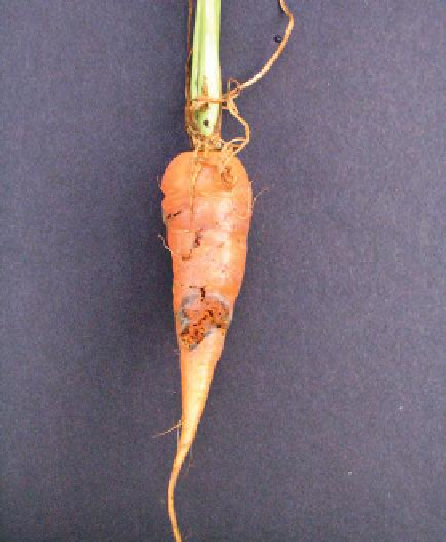Agriculture Reference
In-Depth Information
(a)
(b)
Figure 18.20
(a) Chrysanthemum leaf mines; (b) carrot fl y damage
Vine weevil (
Otiorhyncus sulcatus
)
around at night, or by the too frequent movement of
pots containing plants with grubs eating their roots.
Control
. Gardeners sometimes use traps of corrugated
paper placed near infested crops. Inspection of plants
at night by torchlight may reveal the feeding adult.
The parasitic nematode
Steinemena carpocapsae
is
used by incorporating it as a drench into compost or
soil. The insecticide
thiacloprid
that was used as an
effective drench against the larvae of this pest has
recently been suspected of a possible involvement in
bee deaths ('
colony collapse disorder
') in Europe.
This species belongs to the beetle group, but as with
all weevils, possesses a longer snout on its head than
other beetles.
Damage
. The larva stage is the most damaging, eating
away roots of crops such as cyclamen and begonias
in greenhouses, primulas, strawberries, young
conifers and vines outdoors, and causing above-
ground yellowing and wilting symptoms similar to root
diseases such as
Verticillium
wilt. Digging around in
the plant's root zone will, however, quickly show the
unmistakable white grubs (Figure 18.21a). The black
adults move around at night and are therefore rarely
seen by the gardener. They may eat out neat holes in
leaves or round the edges of the foliage of plants such
as rhododendron, raspberry and grapes, and many
herbaceous perennials.
Life cycle
. The adult is 9 mm long, black in colour,
with a rough textured cuticle (Figure 18.21b). The
forewings are fused together, the pest being incapable
of flight. No males are known. The female lays eggs
(mainly in August and September) in soil or compost,
next to the roots of a preferred plant species. Over a
period of a few years, she may lay 1,000 eggs as she
visits many plants. The larvae are white and legless,
with a characteristic chestnut-brown head. They reach
1 cm in length in December when they pupate in the
soil before developing into the adult.
Spread
. This is achieved by the female adult crawling
Wireworm
Click beetles
(
Agriotes lineatus
)
are
commonly found in
grassland, but the wireworm larvae (see Figure 18.10)
will bore through other plants such as potatoes and
carrots. Some gardeners dig in green manure crops
to lure wireworms away from underground roots and
tubers. A nematode (
Heterorhabdis megadis
) can be
purchased for biological control.
Garden chafer (
Phyllopertha horticola
)
This
is
increasingly proving a problem on turf, where
the large white grubs eat the roots. Small yellow
patches appear in the lawn, notably in summer when
the grubs are becoming fully grown. While healthy,
well-fertilized lawns often show minimal damage, the
gardener may need to use a biological control, involving
the tiny nematode (
Heterorhabditis bacteriophora
).



